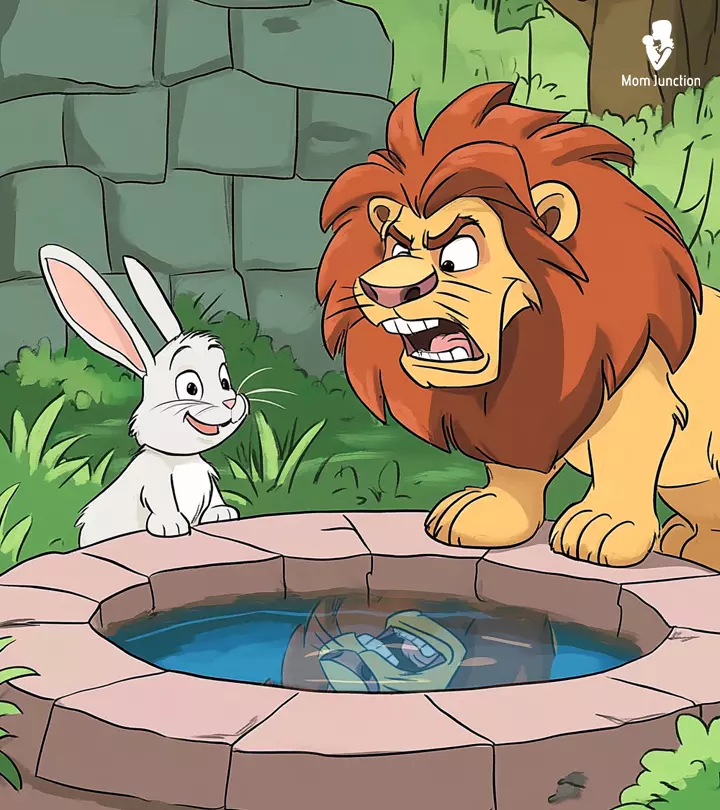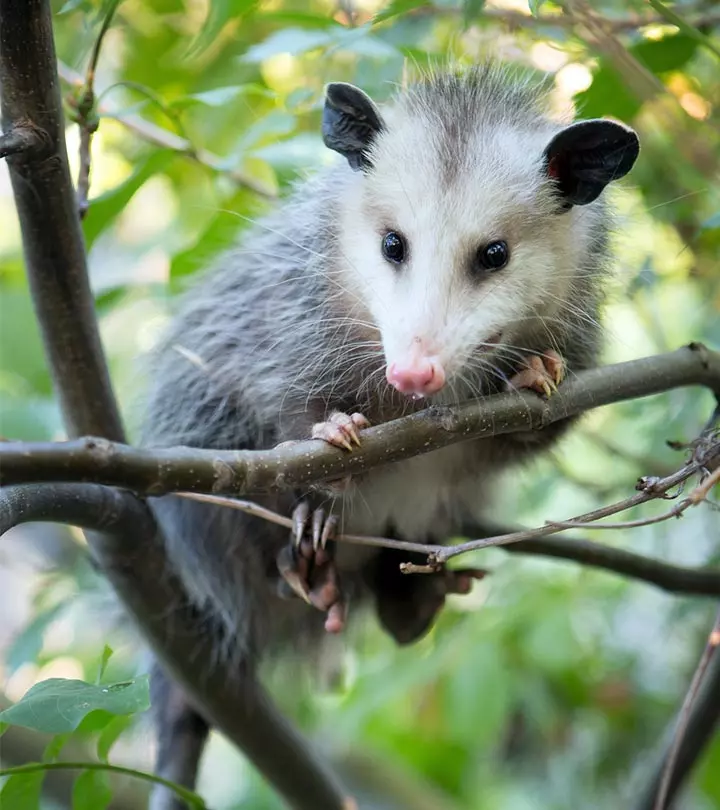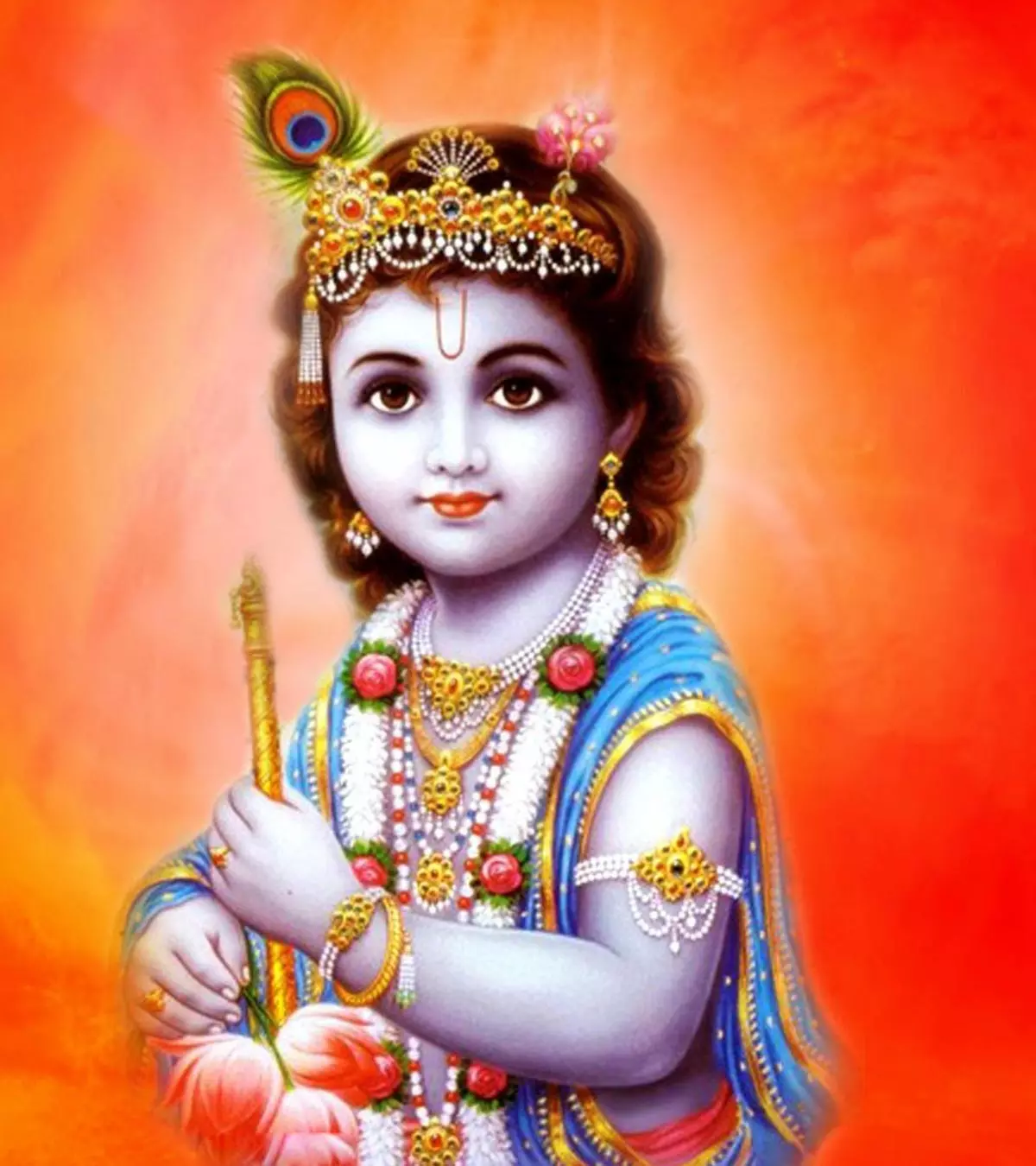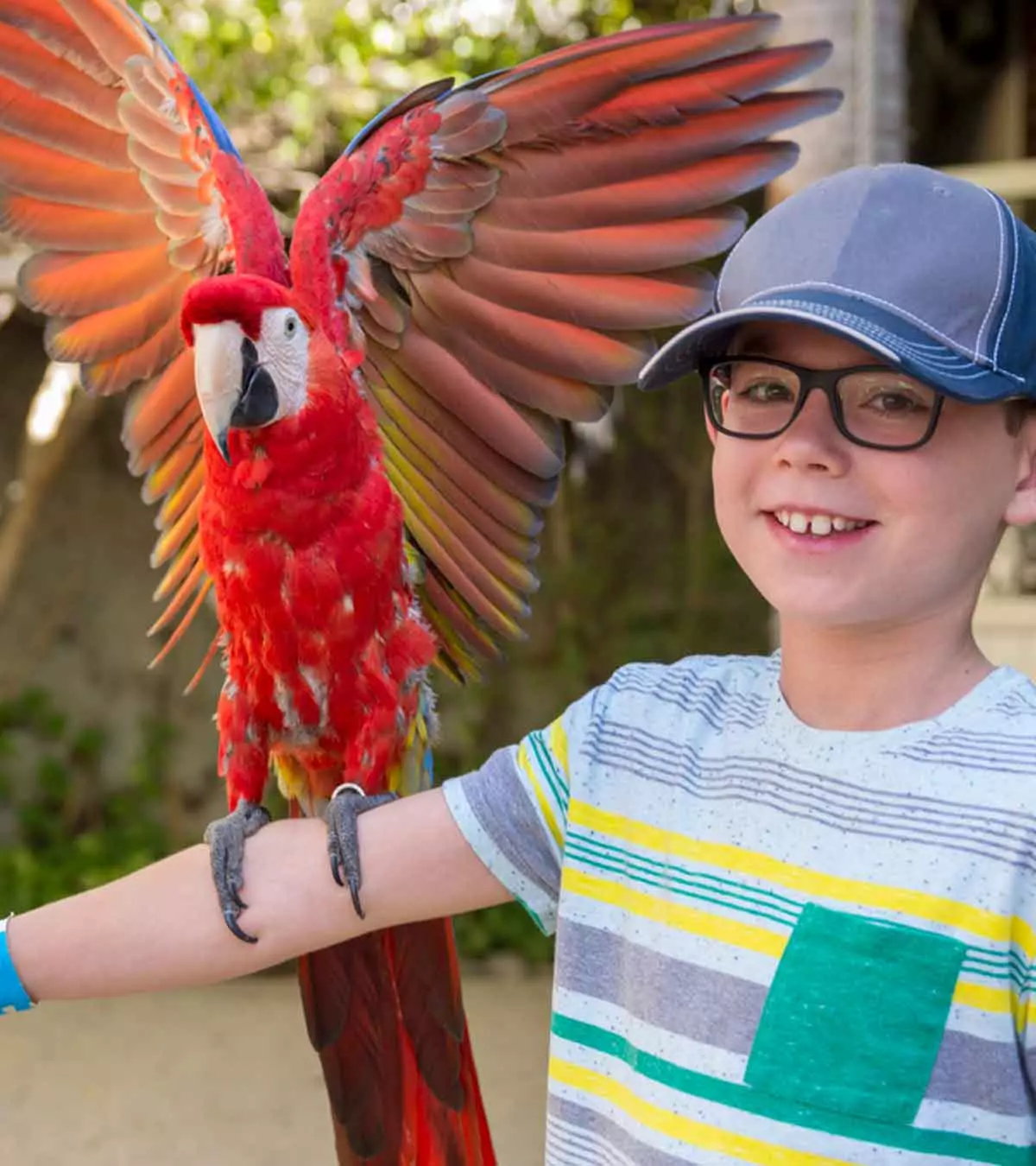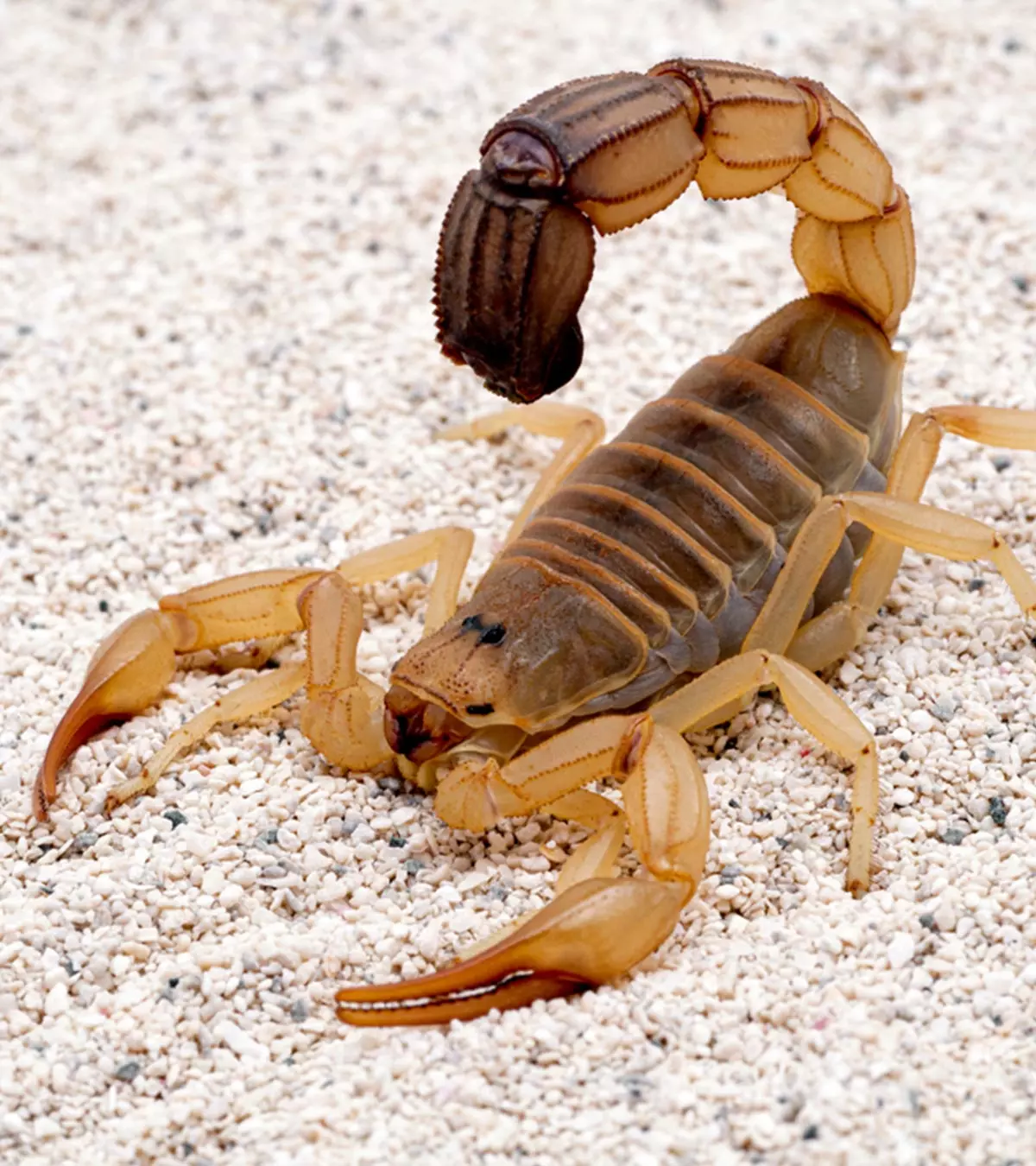
Image: Shutterstock
Scorpions are fearsome creatures that resemble lobsters. These fierce predators with long pincers are found on all the continents except Antarctica. Read these engrossing scorpion facts for kids to know more about these intriguing arthropodsiInvertebrate animals (including insects) with a rigid external skeleton, a segmented body, and jointed legs. . These facts share information about the scorpion’s body, diet, habitat, reproduction, and life cycle. Share these facts with your child to satiate their inquisitiveness about these fascinating arachnids. Knowing about Scorpions will help children understand that no matter how captivating these creatures are, maintaining a safe distance from them is necessary to be safe and healthy. Read on to know engaging scorpions facts for kids that you can share with your children.
Key Pointers
- Scorpions have eight legs, their body is divided into two parts, and they do not have wings like many other insects.
- Scorpions eat insects, and they can slow down their metabolism to survive up to a year just by eating one insect.
- They do not have bones or vertebrae in their body. Thus, they belong to invertebrates. Scroll down for more facts.
Is Scorpion An Insect?
No, in fact, they prey on insects. Creatures that fall into the category of insects need to have specific anatomical structures, including six legs, one or two pairs of wings, and a body that is divided into three parts, namely the head, thoraxiThe body segment located between the neck and abdomen, where the insect's wings and legs are attached. , and abdomen. Scorpions are eight-legged creatures with no wings, and their bodies are divided into two parts, namely the cephalothorax or prosoma and the abdomen or opisthosoma (more on this below). As they have eight legs, they are classified as arthropods, and as they have multiple leg segments, they are classified as a myriapod as well.
What Do Scorpions Eat?
Scorpions are born with a survival instinct and are designed to survive in harsh climates. Their diet primarily consists of insects. They fall under the arachnid class category in biology. They are opportunistic predators, so they consume other arachnids such as spiders and other scorpions, pill bugs, snails, and lizards. Compared to other arachnids (spiders, ticks, mites, etc.), scorpions have the unique ability to slow their metabolism and oxygen intake such that they can survive on only one insect a year. They are also able to quickly attack and hunt their prey whenever the need arises.
What Does A Scorpion Look Like?
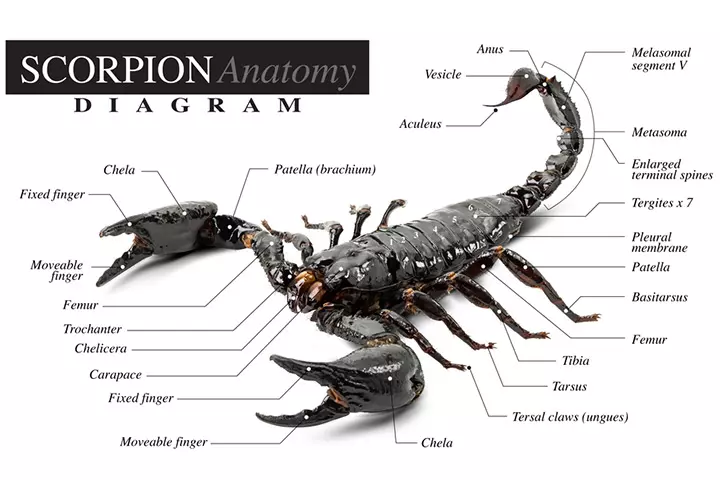
The anatomy of a scorpion has been explained in detail below.
- Scorpions have a hard exoskeletoniA rigid external skeleton that supports and protects an insect's body. made out of chitin — a hard, protective, and flexible substance composed of polysaccharide and nitrogen.
- A scorpion’s body is divided into two major components — the cephalothorax and the opisthosoma.
- The cephalothorax is a fused head and thorax, comprising the eyes, mouth, and chelicerae. It contains a pair of eyes at the top, called the median eyes, and two to five pairs of eyes at the sides called the lateral eyes.
- The front third of its body is covered with a hard material called carapace.
- The opisthosoma is the posterior part of the body that is attached to the cephalothorax. It comprises the abdomen and respiratory organs of the scorpions. The section of opisthosoma that bears the legs is called the mesosoma.
- The telson is a bulb located at the end of a scorpion’s body and consists of the two venom glands. It is covered with sensory hairs on the outside. This bulbous part of a scorpion’s body, with its sting or aculeus, is responsible for puncturing the chosen prey and transferring the potent venom that kills the prey.
- The segmented curved tail and the stinger of a scorpion’s body form the metasoma — the posterior section of the opisthosoma.
- The chelicerae are jaw-like structures right outside the mouth of the scorpion. They help the scorpion hold and crush the prey before swallowing it.
Where Do Scorpions Live?
This predator arachnid is built to survive in the toughest environments of the world. Even when exposed to harsh climates and temperatures, scorpions can adapt and survive. However, the only thing that these burrowing creatures cannot live without is soil. You will usually find them everywhere you find soil — in deserts, forests, and mountainous areas.
Though scorpions now live on dry land, the fossil of ancient sea scorpions has been found in several parts of the world. This creature was called Eurypterid and was alive in the Paleozoic era. It resembles scorpions and other arachnids.
How Many Legs Do Scorpions Have?

Scorpions are eight-legged arachnids. Their pedipalps can be confused with their legs. The pedipalps are a pair of appendages attached at the anterior end of the cephalothorax. Each pedipalp ends with a claw- or pincer-like structure called chela, which gives a distinctive look to a scorpion.
Pedipalps serve several purposes, including prey capture, self-defense, courtship, and burrow excavation.
Reproduction And Life Cycle Of A Scorpion
Scorpions observe sexual reproduction, that is, reproduction takes place through mating between a male scorpion and a female scorpion.
- First, the females release an attractant or chemical scent called pheromonesiSubstances (scents) released by an organism that serves as the means of species-specific communication. , which attract males searching for a mate.
- Once the male tracks down the female, it uses its pedipalps to get a hold of the female’s pedipalps. They hold on to each other and indulge in a sort of dance. The male then deposits the sperm inside the female through the transfer of spermatophore, which is a capsule or mass containing the sperms.
- On coming in contact with this structure, the female draws the sperms into her genital pores for fertilization.
- The fertilized eggs remain inside the female’s body and develop into embryos. These are nourished inside the body for anywhere between a few months to a year.
- Once the gestation period ends, the mother delivers the baby scorpions or the nymphs.
- The nymphs climb onto their mother’s back soon after delivery and remain there until their first molt (shedding of skin).

- After going through a series of molting phases, the nymphs become mature enough to fend for themselves.
You can broadly divide the life cycle of a scorpion into:
- Eggs
- Nymphs
- Adults
20 Facts About Scorpions For Kids
- Scorpions belong to the scientific order called Scorpiones, derived from the Latin word scorpius.
- Scorpions are invertebrates, meaning they have no vertebrae or bones inside their body.
- Scorpions belong to the class of arachnids or joint-legged invertebrates and are closely related to camel spiders, mites, solifugae, and ticks.
- The average lifespan of a scorpion is around 3–8 years.
- A full-sized adult scorpion’s length ranges from 2.5–8in.
- Scorpions are carnivorous, and thus, eat insects, arachnids, reptiles, and even small mammals.
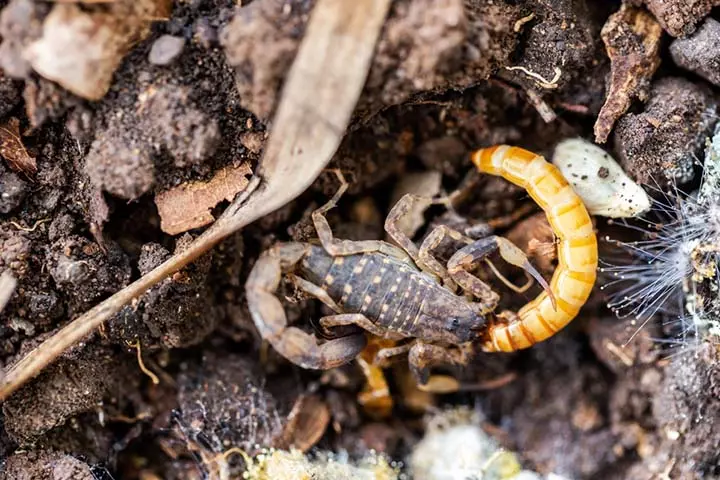
- The mating season for scorpions is usually from spring to early fall.
- The average size of a female scorpion’s brood is 25, although some species may have a brood size of 100.
- There are more than 2,000 scorpion species in the world.
- Only about 30 to 40 species of scorpions have poison that is strong enough to kill a human.
- Did you know that most scorpions glow under ultraviolet light? The phenomenon is due to the presence of certain chemicals in the scorpion’s exoskeleton, which is called the cuticle.
- In rare cases, a scorpion’s mating ritual could lead to stinging or sexual cannibalism. For this reason, the males usually leave from the spot as soon as the process of mating is complete.
- Unlike most arachnids, scorpions are not oviparous, meaning they do not lay their eggs. Scorpions are viviparous, meaning they give birth to live young ones.
- Scorpions are nocturnal and usually hunt at night.

- Scorpion babies are often confused with larvae, but they are not. They are miniature versions of the adults.
- Baby scorpions or scorplings are very tender and vulnerable when born and need the attention and care of the parents at least until their first molt.
- Baby scorpions molt an average six times before they become adults.
- The mating process in scorpions could take almost an entire day.
- Scorpions usually hibernateiA state of inactivity or sleep in the animals to conserve energy and survive extreme weather. during the winter since they prefer warmer weather.
- Scorpions are believed to have been around before the age of the dinosaurs.
Frequently Asked Questions
1. Can scorpions fly?
Scorpions do not have wings, and they cannot fly. However, a flying scorpion called a scorpionfly is an insect with wings and can fly for a short duration. It is often confused with a scorpion (1).
2. How long can scorpions go without water?
Scorpions can survive without water or food for more than a year. To remain cool and conserve energy, they live under logs and rocks. They are most commonly found among the fauna of tropical, desert, grassland, and mountain habitats.
3. What is the most venomous scorpion in the world?
The death stalker is considered the most venomous scorpion in the world (5).
4. What is the gestation period for scorpions?
The gestation period for scorpions varies depending on the species, and it may be around seven to eight months (6).
5. What are some scorpion-related activities for kids?
If your child is interested in learning more about scorpions, watch documentaries on arachnids with them or take them on a nature walk and help them spot insects and compare them to scorpions. You can also engage them in scorpion crafts, such as paper scorpions or puppet scorpions.
These scorpion facts for kids can fulfill your little one’s curiosity and help them learn more about this amazing creature. Just like other science facts for kids, these details about scorpions will fascinate young minds. Scorpions are considered invertebrates since they don’t have vertebrae or bones inside their body. They are designed to survive in the toughest of conditions and are nocturnal. So, share these facts about scorpions with your budding zoologist, and they will be all ears. However, warn your child against approaching or touching the creature as they are venomous and dangerous.
Infographic: Interesting Scorpion Facts For Children
Scorpions are eight-legged animals known for grasping pincers, aiding them in movement, survival, and protection. But did you know that their evolution dates back hundreds of millions of years ago? We bring more startling facts about scorpions you can share with your child(ren). Illustration: Momjunction Design Team
Illustration: Fun And Interesting Scorpion Facts For Kids

Image: Stable Diffusion/MomJunction Design Team
Discover the truth about the feared Scorpion’s sting! Learn if it’s really as fatal as people think in our video on Scorpion Facts: the (not so) fatal sting!
References
- Common Scorpionflies.
https://entomology.umn.edu/common-scorpionflies - Insects and Scorpions at Work.
https://www.cdc.gov/niosh/outdoor-workers/about/insects-and-scorpions.html - Tailless Whip-Scorpion.
https://www.fs.usda.gov/detail/arp/learning/nature-science/?cid=fsbdev3_042936 - Water Scorpions.
https://mdc.mo.gov/discover-nature/field-guide/water-scorpions - A sting in the tail.
https://www.britishecologicalsociety.org/press-sting-tail-high-speed-video-captures-death-stalker-scorpions-strike/ - Carlos E. Santibáñez-López et al.; (2015); Scorpions from Mexico: From Species Diversity to Venom Complexity.
https://www.mdpi.com/2072-6651/8/1/2
Community Experiences
Join the conversation and become a part of our nurturing community! Share your stories, experiences, and insights to connect with fellow parents.
Read full bio of Katherine Paxton
Read full bio of Sravani Rebbapragada
Read full bio of Harshita Makvana
Read full bio of Praggya Joshi









